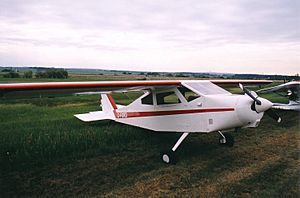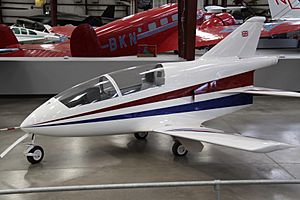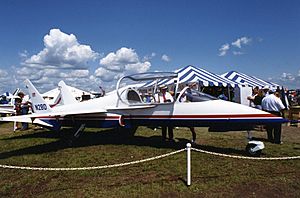Jim Bede facts for kids
Quick facts for kids
James R. Bede
|
|
|---|---|

Aircraft designer Jim Bede, at the BD-5 Expo 2000 in Fort Worth, Texas
|
|
| Born | April 17, 1933 |
| Died | July 9, 2015 (aged 82) Cleveland, Ohio, U.S.
|
| Nationality | American |
| Occupation | Aircraft designer |
James R. Bede (born April 17, 1933 – died July 9, 2015) was an American aircraft designer. He created many airplanes starting in the 1960s. However, his businesses often faced problems. This meant most of his designs were not widely used.
Contents
Jim Bede's Early Life and Bede Aviation
Jim Bede grew up in Cleveland, Ohio. He finished West Technical School in Cleveland in 1952. He then studied at Fenn College and the Municipal University of Wichita. In 1957, he earned his degree in Aeronautical Engineering. That same year, he started working as an engineer at North American Aviation. There, he helped with projects for the United States Navy.
Bede soon returned to Cleveland in 1961. He started a company called Bede Aviation with his father. Their goal was to make airplanes that people could build themselves from kits. At the time, buying a ready-made airplane was very expensive. Bede thought that if people built their own planes, they could save a lot of money on labor costs.
The first plane he designed was the BD-1. It was a simple, two-seat plane. It used new building methods, like aluminum honeycomb material. This made the plane light but very strong. It was designed to be able to do aerobatics (fancy flying tricks). It was also expected to be fast, reaching about 135 knots (250 km/h). This was much faster than other small planes like the Cessna 152.
To make the BD-1 even more useful, its wings could fold. This meant owners could tow it behind a car. They could store it at home and drive it to the airport. The kit was planned to cost around US$2,500.
Developing the BD-1 took a long time and a lot of money. In 1968, some Cleveland businessmen took over the company. They renamed it American Aviation. They decided to build the planes in a factory instead of selling kits. The design was later changed to make it more stable. The AA-1 and other designs, like the four-seat AA-5 Traveller, became quite popular. Later, the company was bought by Grumman and became Grumman American.
Record Flights and Experiments
While working on the BD-1, Bede also designed other planes. One was the XBD-2. This was an experimental plane that used a special system. It had 164,000 tiny holes in its wings. These holes sucked air from the wing's surface. This helped the plane fly better and lift more weight. The XBD-2 also had two engines that powered a single propeller at the back. After 50 hours of testing, the plane was given to the Experimental Aircraft Association.
Bede also worked on a record-breaking flight. He modified a Schweizer SGS 2-32 glider. He called it the BD-2 and nicknamed it "LOVE." This stood for "Low Orbit, Very Efficient." He added many extra fuel tanks to the plane. In October 1969, Bede set a 70-hour endurance record. This means he flew for 70 hours without landing. The flight ended early due to an electrical problem. He had flown almost 9,000 miles (14,500 km).
Bede Aircraft and the BD-4
Jim Bede still believed in the idea of kit planes. He started a new company called Bede Aircraft. Here, he began designing an even simpler plane to build, the Bede BD-4.
The BD-4 used more traditional building methods. It was a high-wing plane with mostly flat aluminum surfaces. One new idea was "panel-rib" construction for the wing. This made the wing faster to build.
The BD-4 also had great performance. With a 108 hp engine, it could reach 130 knots (240 km/h). It could also use bigger engines, flying up to 190 knots (350 km/h). The plane could be built with either a tricycle landing gear or a tail-dragger setup.
The BD-4 first appeared in 1968. Thousands of plans were sold, and hundreds of these planes were built. Many are still flying today. It has a very good safety record.
The BD-5 Micro Jet
Even while working on the BD-4, Bede started a more ambitious design. This was the BD-5 Micro.
The BD-5 was a tiny single-seat plane. It looked like a small jet fighter. The pilot sat almost lying down under a clear plastic canopy. It was first planned to be made of fiberglass panels over an aluminum frame. It would have a small engine driving a propeller at the back. The plane also had landing gear that could be pulled up into the plane.
Bede started designing the BD-5 in 1967. Serious work began around 1970. They published an information booklet in early 1971. Magazines like Popular Science wrote about it. On February 24, 1971, people started placing orders. They paid a $200 deposit to reserve a kit. By the end of that year, over 4,000 orders had been placed!
The first prototype flew briefly on September 12, 1971. It used a snowmobile engine. The original V-shaped tail made the plane hard to control. In 1972, Bede hired Burt Rutan to help. Rutan made many improvements, including a new, larger tail.
A big problem was that the engines kept failing. The plane needed a light engine, less than 100 pounds (45 kg). Bede tried several different two-stroke engines. These engines were light but not very reliable. Eventually, Bede offered the kit without an engine. Many people bought the kits, hoping to add an engine later. But then, the engine supplier went out of business. This caused long delays. By the time 5,100 kits were shipped, the company was in financial trouble.
Bede's company went bankrupt in 1979. It was found that money meant for building kits was spent on other projects. Because of this, Bede was not allowed to take deposits for aircraft for ten years.
The BD-5J Jet Version
While testing engines for the BD-5, Bede decided to try something different. He created a version with a small jet engine. This was the BD-5J. It could fly at 300 mph (480 km/h)! It used a small Sermel TRS-18-046 turbojet engine.
The BD-5J became very popular at airshows. It was even featured in the opening scene of the James Bond movie, Octopussy. For many years, the BD-5J held the Guinness record for the World's Smallest Jet.
Bede Design and Cars
After his aviation company faced problems, Bede worked on other engineering projects under Bede Design.
One project was with his cousin to create the Bede Car. This car used an 80 hp motorcycle engine. It had a special fan to push it forward. The car was mostly made of fiberglass and aluminum. It was supposed to be very light, less than 1,000 pounds (500 kg). The goal was to get amazing fuel economy, about 120 miles per gallon.
However, the prototype car did not work well. It was too weak at low speeds. It couldn't even drive up a sloped driveway easily. The company that planned to make it, Bede Industries, decided it wasn't practical.
Another car project followed. This was a smaller, motorcycle-like vehicle. It was called the Autocycle, then the BD-200, and later the LiteStar and Pulse. About 360 of these were made and sold.
Bede Jet and the BD-10
In 1989, Bede announced a new project: a two-seat, high-speed jet called the Bede BD-10. He formed a new company, Bede Jet, for this plane.
Learning from past engine problems, Bede chose a proven jet engine, the General Electric J85. He designed the plane around it. The BD-10 looked a bit like the Northrop T-38 Talon jet trainer. It was expected to be incredibly fast and fly very high. It was claimed to reach supersonic speeds of Mach 1.4.
Bede's prototype was finished in 1992. During testing, the plane gained a lot of weight. Its range was much shorter than planned. It also couldn't fly as fast as expected, reaching only Mach 0.83. The project eventually stopped.
Sadly, several BD-10 planes crashed, leading to deaths. The company declared bankruptcy in 1997.
Bede Aircraft, Again
During the BD-10 project, Bede also started designing updated versions of the BD-5. These were the two-seat Bede BD-12 and the four-seat Bede BD-14. These were designed under a new company, also called Bede Aircraft.
Again, people placed deposits to reserve kits. The BD-12 was designed to be very easy to build, with only a few hundred parts. It was claimed that the plane could be built and flown in just two weeks.
By early 1995, the BD-12 prototype still hadn't flown. When it was almost finished, it was found to be too heavy at the back. Lead weights had to be added to the front for it to fly safely. The prototype finally flew in the fall of 1995. However, it was almost destroyed on its first flight due to stability problems.
A few months later, Bede's company faced financial trouble again. They had to move their workshop.
BedeCorp and Later Designs
Bede then started a new design company called BedeAmerica Aerosport. In 1998, he promoted a six-seat version of the BD-4, called the BD-16. But this didn't get much interest. He then moved on to the single-seat BD-17 Nugget and the two-seat BD-18. These were updated versions of his original BD-1 design.
The BD-17 was announced in 2000. It was even simpler to build, with only 110 parts. It began flight testing in 2003 and was found to fly very well.
Death
Jim Bede passed away on July 9, 2015, in Cleveland, Ohio, at the age of 82. He died from an aneurysm.
Images for kids
See also
 In Spanish: Jim Bede para niños
In Spanish: Jim Bede para niños










